Panicle and shoot dieback
By Elizabeth Dann, Akila Prabhakaran and Kaylene Bransgrove
This article provides an update of our current understanding and research efforts concerning panicle dieback in avocados (read the previous article here). Fruit yields in 2021 will again be significantly impacted in some orchards/blocks.
In mature, fruiting trees, dieback of the flower shoot was observed again in 2020 in Queensland’s Bundaberg/Childers growing region, where we first became aware of the severity of this issue. Rather than a death or blight of flowers themselves, which occurs less commonly, the main yield-limiting symptom was dieback, which became apparent 6-8 weeks after peak flowering. At this time, flowers had well and truly abscised or set, and fruitlets were mostly pea to olive sized, and up to golf ball sized. Dieback in these fruiting shoots caused disrupted water flow to developing fruitlets, which shrivelled and turned black eventually abscising to leave the ‘skeleton’ of the inflorescence (Figures 1, 2 and 5). Later in spring after peak flowering we frequently see epicormic shoots and subsequent leaf flush behind the panicle skeleton (Figure 3, 4). Where this has occurred for a couple of years, there is a “knuckle”-like appearance (Figure 3). During the summer, trees make a rapid recovery, with vegetative flush arising from warm weather, good irrigation and nutrition and a lack of crop to arrest vegetative growth (Figure 5).
We have received reports, photos and samples from North Queensland and south-west Western Australia, so the problem is certainly not confined to Central Queensland. Symptoms and anecdotal information seem to be consistent across all regions, ie it has been noticed in previous years, but seems to be getting more severe (or we are more aware of it now). Panicle and shoot dieback first becomes apparent during early fruit development, and is worse in Hass and Maluma, but virtually unknown in Shepard; it is associated predominantly with heavy defoliation and functionally determinate flowering. Individual trees or sections of blocks can be worse than others, and it can be surprising to see in trees which have not defoliated much at flowering and otherwise appear to be healthy.
The Avocado Pathology team at UQ have continued to process samples collected by our team or sent in by growers and agronomists from across Australia’s growing regions. The fungi most frequently and consistently isolated are Alternaria spp., Colletotrichum and several others, and less often fungi from the Botryosphaeriaceae family (commonly held responsible for dieback in avocado and other tree crops). Colletotrichum and Botryosphaeria species are well-known pathogens of avocado, causing fruit postharvest diseases anthracnose and stem-end rot. Alternaria spp. are also very common in plant tissues as saprophytes or secondary colonisers (and as primary pathogens in many crops, eg A. solani causing early blight in tomato and potato), and their capacity to cause disease in avocado is currently under investigation. There is insufficient evidence at this stage to confirm that fungi are the primary cause of the problem. A complex of factors is likely involved, including tree stress at flowering (and perhaps stress as early as floral initiation, several months before flowering), abundance of flower compared with leaf, root systems which can’t support the demand for water at flowering, and other environmental factors such as hot drying winds, poor quality (high salinity) irrigation water, sunburn, hail damage etc.
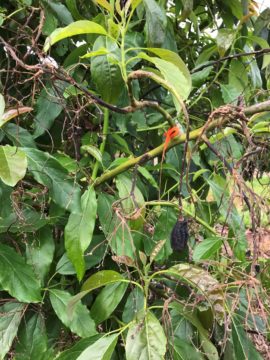
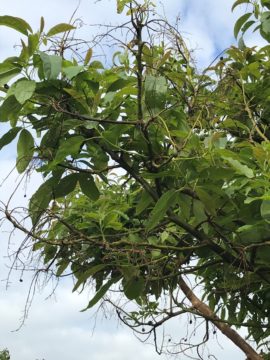
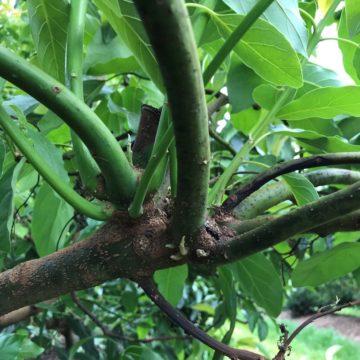
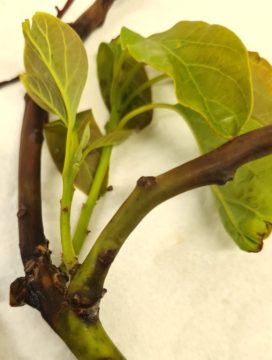
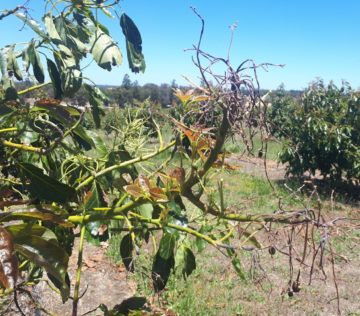
Panicle and shoot dieback in young trees
In Australia, another dieback issue often affects newly planted trees (eg up to 12 months old). We have seen dieback of vegetative shoots, and frequently of flowering shoots as well (Figures 6, 7), and in both cases this can lead to death of the tree. Nurseries collect Hass budwood for grafting from physiologically mature trees, which are programmed to flower and set fruit. Thus, they may be predisposed to flower instead of putting on vegetative growth. Flowering in trees <12 months after planting (and sometimes while still in the nursery), places undue stress on these young trees, which may not have the root systems to support the high demand for water and nutrients at flowering and set, thus succumbing to dieback. Our extensive diagnostic work over the last year or so shows that the dieback can be related to severe destruction of the root systems by Phytophthora cinnamomi (Figure 8) or necrosis at the graft union caused by Colletotrichum spp. or other fungi (Figure 9). If root systems are relatively healthy, shooting of the rootstock below the graft is common (Figures 6, 7).
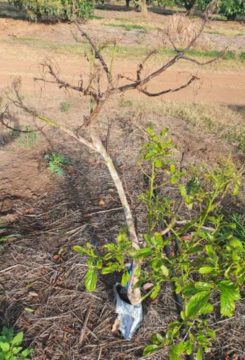
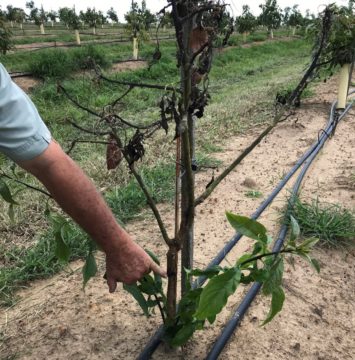
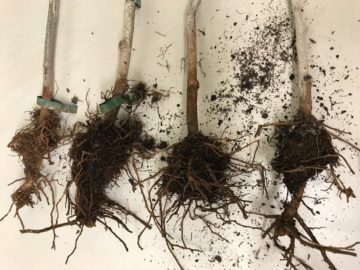
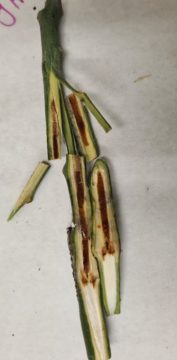
What are we doing about it?
Research activity has been included in the industry-funded project Improving avocado orchard productivity through disease management (AV16007) to investigate the issue/s.
- Two field trials in Central Queensland commenced in September 2020. There are 10 fungicide treatments, including nil and industry standard controls. There are 4 curative fungicides (with post-infection activity), which are not currently registered in avocado.
- First sprays commenced during flowering, with no observable phytotoxicity. Follow up applications will continue as per industry standard programs until harvest.
- We have collected limited data on fruit retention and severity of dieback, with final yields and postharvest disease severity to come. Effects of fungicide treatments on panicle dieback may not be apparent until the following flowering and set, assuming that fungi play a major role.
- Two sections of 5 consecutive trees with severe panicle dieback (Figure 10, 11) were injected with phosphonate then heavily pruned 4-6 weeks later and painted for sunburn protection (Figure 12). These trees will be monitored for flowering and occurrence of dieback during September to December 2021
- The relative aggressiveness or pathogenicity of different fungi to cause severe disease e.g. blight of flowers or dieback in branches, is currently under investigation in glasshouse trials.
- Evaluation of different fungicides or biofungicides as pruning wound or post-hail dressings is in final stages.
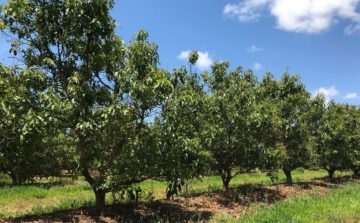
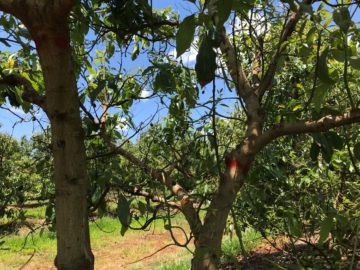
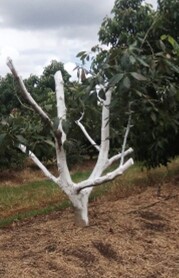
What can you do about it?
As for management strategy, maintaining optimum tree health at all times by good agronomic and Phytophthora root rot management is important. Growers should also encourage strong root growth so that trees have the necessary root systems to support the heavy demand for water at flowering. Consider removing excessive panicles prior to full bloom, prune out the branches with dieback and maintain good orchard hygiene practices. The dieback skeletons harbour abundant spores of pathogenic fungi (Figure 13), which can cause new infections on fruit surfaces leading to anthracnose in mature, ripe fruit.
For newly planted blocks, minimise tree stress! Plant trees with abundant, disease-free roots, protect them from sun and wind, don’t over-water, and walk through rows to remove flower buds to favour spring and summer vegetative growth to help the young trees establish.
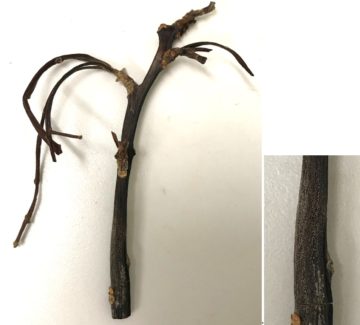
More information
This QAAFI science seminar was presented by the AV16007 team on 17 August 2021
Acknowledgement
The Improving avocado orchard productivity through disease management (AV16007) project is funded by Hort Innovation, using the avocado research and development levy, and contributions from the Australian Government. Thank you to the many growers, farm managers and agronomists who have provided samples and helpful information, and to our field trial collaborators.

This article was produced for Talking Avocados and Avoscene, in January 2021.
Date Published: 28/07/2021